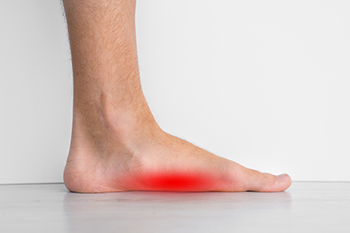Connect With Us
Blog

Flat feet occur when the arch does not lift properly, causing the entire sole to touch the ground and placing extra pressure on the feet and ankles. This can begin in childhood or develop later from tendon problems like a tight Achilles tendon or weakness along the inside of the ankle. People with flat feet may feel aching in the arches, stiffness, or fatigue after long periods of walking or standing. Some notice the ankles leaning inward or calluses forming from added friction. A podiatrist can evaluate the arch, check tendon strength, and determine how the flat feet affect foot movement. Treatment options include orthotics to support the arch, improve alignment, and reduce strain, along with guidance on shoe choices. The podiatrist can also discuss surgery if the bones or tendons need correction. If you have foot problems related to flat feet, it is suggested that you make an appointment with a podiatrist for a diagnosis and treatment.
Flatfoot is a condition many people suffer from. If you have flat feet, contact one of our podiatrists from Garnet & Carbonell, DPM, LLC. Our doctors will treat your foot and ankle needs.
What Are Flat Feet?
Flatfoot is a condition in which the arch of the foot is depressed and the sole of the foot is almost completely in contact with the ground. About 20-30% of the population generally has flat feet because their arches never formed during growth.
Conditions & Problems:
Having flat feet makes it difficult to run or walk because of the stress placed on the ankles.
Alignment – The general alignment of your legs can be disrupted, because the ankles move inward which can cause major discomfort.
Knees – If you have complications with your knees, flat feet can be a contributor to arthritis in that area.
Symptoms
- Pain around the heel or arch area
- Trouble standing on the tip toe
- Swelling around the inside of the ankle
- Flat look to one or both feet
- Having your shoes feel uneven when worn
Treatment
If you are experiencing pain and stress on the foot you may weaken the posterior tibial tendon, which runs around the inside of the ankle.
If you have any questions, please feel free to contact our offices located in Palmetto Bay, South Miami, and Homestead, FL . We offer the newest diagnostic and treatment technologies for all your foot care needs.

Falls in the workplace are a common cause of injury and can often be prevented with proper safety habits. Using the right size ladder for the task helps ensure stability and reduces overreaching. Standing on the lowest rung possible provides better balance and control while working at height. Keeping the body centered on the ladder helps maintain proper alignment and lowers the risk of tipping or slipping. Additionally, wearing supportive footwear with good traction is also important for maintaining grip and balance. A podiatrist can help by evaluating foot health, balance, and gait, as well as recommending proper shoes or custom orthotics to improve stability on the job. If you have foot or ankle pain from falling at work, it is suggested that you consult a podiatrist who can treat various foot conditions, and offer additional fall prevention tips.
Preventing falls among the elderly is very important. If you are older and have fallen or fear that you are prone to falling, consult with one of our podiatrists from Garnet & Carbonell, DPM, LLC. Our doctors will assess your condition and provide you with quality advice and care.
Every 11 seconds, an elderly American is being treated in an emergency room for a fall related injury. Falls are the leading cause of head and hip injuries for those 65 and older. Due to decreases in strength, balance, senses, and lack of awareness, elderly persons are very susceptible to falling. Thankfully, there are a number of things older persons can do to prevent falls.
How to Prevent Falls
Some effective methods that older persons can do to prevent falls include:
- Enrolling in strength and balance exercise program to increase balance and strength
- Periodically having your sight and hearing checked
- Discuss any medications you have with a doctor to see if it increases the risk of falling
- Clearing the house of falling hazards and installing devices like grab bars and railings
- Utilizing a walker or cane
- Wearing shoes that provide good support and cushioning
- Talking to family members about falling and increasing awareness
Falling can be a traumatic and embarrassing experience for elderly persons; this can make them less willing to leave the house, and less willing to talk to someone about their fears of falling. Doing such things, however, will increase the likelihood of tripping or losing one’s balance. Knowing the causes of falling and how to prevent them is the best way to mitigate the risk of serious injury.
If you have any questions, please feel free to contact our offices located in Palmetto Bay, South Miami, and Homestead, FL . We offer the newest diagnostic and treatment technologies for all your foot care needs.

Plantar fasciitis is a common source of heel and arch pain that develops when the thick band of tissue along the bottom of the foot becomes irritated. It may look normal on the surface, yet the foot can feel stiff, tender, or sharp with pain that is most noticeable during the first steps in the morning or after periods of rest. Symptoms include aching in the heel, tightness through the arch, and discomfort that increases with prolonged standing or activity. Causes may involve overuse, wearing unsupportive footwear, high or low arches, or sudden increases in exercise. A podiatrist can begin by evaluating your foot structure, checking for inflammation, and identifying related biomechanical issues. Once diagnosed, treatment may include stretching programs, footwear guidance, custom orthotics, or targeted interventions to reduce strain on the plantar fascia. Because early attention can ease pain and prevent long-term problems, it is suggested that you schedule an appointment with a podiatrist for effective relief and treatment solutions.
Plantar fasciitis can be very painful and inconvenient. If you are experiencing heel pain or symptoms of plantar fasciitis, contact one of our podiatrists from Garnet & Carbonell, DPM, LLC. Our doctors can provide the care you need to keep you pain-free and on your feet.
What Is Plantar Fasciitis?
Plantar fasciitis is the inflammation of the thick band of tissue that runs along the bottom of your foot, known as the plantar fascia, and causes mild to severe heel pain.
What Causes Plantar Fasciitis?
- Excessive running
- Non-supportive shoes
- Overpronation
- Repeated stretching and tearing of the plantar fascia
How Can It Be Treated?
- Conservative measures – anti-inflammatories, ice packs, stretching exercises, physical therapy, orthotic devices
- Shockwave therapy – sound waves are sent to the affected area to facilitate healing and are usually used for chronic cases of plantar fasciitis
- Surgery – usually only used as a last resort when all else fails. The plantar fascia can be surgically detached from the heel
While very treatable, plantar fasciitis is definitely not something that should be ignored. Especially in severe cases, speaking to your doctor right away is highly recommended to avoid complications and severe heel pain. Your podiatrist can work with you to provide the appropriate treatment options tailored to your condition.
If you have any questions, please feel free to contact our offices located in Palmetto Bay, South Miami, and Homestead, FL . We offer the newest diagnostic and treatment technologies for all your foot care needs.

